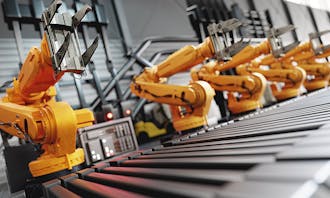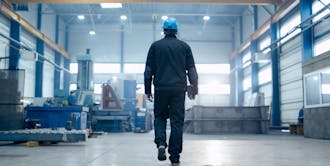- Home >
- Interviews >
-
Sarah Barnes-Humphrey
Sarah Barnes-Humphrey - Let's Talk Supply Chain
2024-05-27
11 min read

Q. Can you introduce yourself and share your journey within the supply chain industry, highlighting pivotal moments that shaped your career path?
I’m Sarah Barnes-Humphrey, a supply chain entrepreneur and founder of Let’s Talk Supply Chain, a leading industry podcast. Supply chain is truly in my blood - growing up in a family of logistics entrepreneurs, I played with trucks, not Barbies. Our dinner table conversations, much to the confusion of any friend I invited over, were about the challenges and successes of running a 3PL.
It may not surprise you that after high school, I joined the family business, working across sales, marketing, customer service and operations, while furthering my industry education in my spare time.
A major turning point was when my family business closed its doors in the fall of 2017. Losing everything forced me to rethink my career and make intentional choices. Before this happened in 2016 I started a podcast and Despite having no prior experience, I kept it going as I searched for a job and this became a key part of my journey. Overcoming a fear of public speaking was another significant challenge. I worked with a talent agent, not to become an actress, but to gain confidence. This led to national TV appearances and big campaigns, preparing me for my current role. I’m not sure I’d be where I am now without those experiences.
Q. Building on that, what inspired you to establish Let’s Talk Supply Chain?
Heading up sales and marketing at my family’s 3PL, I listened to a lot of podcasts. But, honestly, a lot of them were a little dry. And I thought that with my industry knowledge, my personality – and perhaps a bit of earnest nativity – that I could do better. So I bought a podcast kit from Amazon, recorded a show, and got 1000 downloads overnight! Proving there was a market for what I was doing.
I used my tendency to hustle to my advantage, taught myself the skills I needed to get started, and got stuck in. I’ve been able to curate conversations easily and with context, I’m naturally curious and use my experience in the field to ask good questions – and the industry has responded.
Myself, and Let’s Talk Supply Chain, have grown a LOT over the years, but my vision has remained the same. To empower diverse voices within the industry, and provide entertaining but valuable content for supply chain.
Q. In exploring Let’s Talk Supply Chain, could you elaborate on its mission and objectives?
Like many founders, I started by solving a challenge. I saw so many providers in the market, especially with the rise of tech, it was overwhelming. I thought "How on earth are supply chain professionals supposed to find out what’s out there, whether they’re the right fit, if they have the budget?" and wanted to create almost an industry resource, exploring these providers and giving them a way to communicate directly to their audience.
The mission behind that objective was always to create conversations in supply chain that are relevant, valuable, fun, and provoke inspiration and innovation.
And, in creating universally relevant content and bringing vendors and buyers together, I’ve created a non-competitive environment and an incredible community. Collaboration really is baked right in!
Q. We'd love to hear about some notable experiences you've had collaborating with companies and industry leaders. What are some highlights or key learnings from these interactions?
Supply chain is about the people, and I have met some of the most incredible people in this industry. From collaborating with brands on my show to interviewing leaders at panels, there is, without question, something to be taken away from every single encounter I’ve had.
As a founder, I’ve learned that no two journeys are the same. Most founders start with a foundational problem to solve, but many come from different backgrounds and industries; they have different experiences based on gender. Understanding that journey and what it takes to become “an overnight success” really brings everything into perspective.
And of course, I’ve learned so much about the industry! What’s fresh in my brain at the moment is AI – people need to remember that AI has been around for a long time, it’s generative AI that’s new.
We talk broadly about ‘supply chain’, but I’ve also learned how variable supply chains are. To understand supply chain holistically, there is a lot to learn and understand. Talented, passionate and dedicated supply chain professionals are key to the future of the industry.
Q. What are some of the most significant changes you've observed in recent years, particularly regarding the adoption of new technologies?
There has been a technology revolution. When I first started, I was still using a typewriter in the office. Now, I’m having conversations about drones that can carry whole containers, self-driving vans and highways in the sky. But the industry, nor many of its leaders, are properly equipped for those changes.
Leaders are overwhelmed with options and they’re constantly being pitched new technology. This has played a part in some of the stats we’ve seen around the failure, or lack of results, in recent digital transformation projects. And, in this climate, that poses an extra risk – with the current cybersecurity challenges coming into play, there’s even more to think about. Organizations aren’t necessarily getting what they need, because they’re not choosing the right partners and solutions.
We need to learn to walk before we can run!
I think, right now, when it comes to AI and technology, businesses need to take a step back. Lay their data foundation, pick a process to automate – understand it, problem-solve, innovate and measure results. Then pick another process and repeat.
”
Supply chain has a data problem. We have vast amounts of incredibly useful data, but it’s too much for teams to manage manually, and there is often a lack of training. AI and machine learning can analyze vast amounts of data in real time to detect patterns, anomalies, and potential risk factors, proactively identifying and addressing potential bottlenecks or disruptions before they escalate into those big periods of downtime.
”
Q. How do you see technologies like AI, machine learning, digital twins and predictive analysis impacting specific areas of supply chain? Can you share a real-world example?
Efficiency is the name of the game. This tech has incredible potential in things like exceptions management, and helping organizations to become proactive rather than reactive.
And ultimately that becomes about freeing up teams and empowering them to become more creative, and more strategic, in their area of supply chain.
The recent Schneider Electric case really interested me. They used AI and machine learning to resolve maintenance issues, and they saved hundreds of thousands of dollars. And DHL Supply Chain found that sites equipped with autonomous solutions had less turnover than those without.
Another exciting technology is simulation. Being able to test theories and strategies in a virtual environment, before letting those strategies out ‘into the wild,’ is going to be a game-changer.
Organizations will be able to see the risks they anticipated, but also the ones they didn’t. They’ll be able to test small variables, like changing a warehouse location or choosing a different lane, and understand the impact on cost, time, risk, efficiency, or any number of other factors. Allowing businesses to make really targeted, data-driven decisions, instead of falling back on ‘gut’ or tribal knowledge.
Q. In your opinion, what are the key factors driving the adoption of these advanced technologies in the supply chain industry, and what barriers still need to be overcome for wider implementation?
Companies are adopting these technologies because, simply put, they need to operate better. The pandemic highlighted a host of issues, from agility and resilience to visibility and collaboration, and businesses know they need to improve. Coupled with a demanding market, all brands have an eye on cost reduction and improved efficiency.
But we aren’t seeing quick successes, because this isn’t an easy area to tackle. We’ve talked about the sheer volume of options, but another key barrier is the tendency for organizations to have a different solution to solve every single different problem. I can see why that works in theory – the solutions are targeted – but it’s led to complex ecosystems and massive tech stacks that are becoming almost unusable.
The integration isn’t there, the visibility isn’t there, and so most users just aren’t using the technology to its fullest potential. To help keep on top of new technologies from current and wider providers, companies should regularly review their tech stack and continuously evaluate their technology investments and report on usage and impact.
Q. When it comes to diversity and inclusion in the supply chain industry, how do you see technology playing a role in creating more equitable opportunities and fostering diverse talent within the industry?
We’ve seen how technology has boosted the work-from-home movement, helping to bring talent from all over the world together. And it’s helped groups that were previously struggling, like working mothers and those with disabilities, to re-access workforces.
Technology is also helping businesses to find, and work with, more diverse suppliers. Digital platforms and automated processes are helping to improve areas like onboarding and validation, allowing diverse business owners more access to opportunities.
In all of these examples, though, we need to make sure that the human element, the change management and desire from leadership, matches the pace of technological advancement.
Q. How can emerging technologies contribute to building more sustainable supply chains?
Emerging technologies hold significant potential to enhance sustainability within supply chains by improving transparency, efficiency, and traceability.
The ability to look up and down the chains, see layers that previously weren’t visible, and measure the organizations within them, holding them to account. This is giving brands a greater ability to impact others and help implement change down the chain. It also gives consumers a greater level of knowledge and empowers them to make more sustainable choices.
The IBM Food Trust, for example, uses blockchain technology to enhance transparency and traceability in the food supply chain. It allows consumers to access detailed information about the journey of their food products, including origin, processing, and transportation, promoting trust and sustainability.
Q. As supply chains become increasingly global and complex, how can technology help address challenges related to supply chain resilience, particularly in the face of unexpected disruptions?
AI can analyze data to predict potential disruptions, while blockchain ensures transparency and traceability. IoT devices enable monitoring of critical infrastructure, and collaborative platforms facilitate rapid communication and coordination among supply chain partners. There are so many different ways that emerging technology empowers organizations to adapt quickly to unexpected disruptions, mitigate risks, and maintain continuity in their supply chains.
With climate change, we’re seeing more and more disruptions because of inclement weather. Advanced technology can be used to predict weather patterns better and provide alternative routes, or alert drivers to an accident, saving them time and keeping the supply chain moving.
I recently heard of a case study that used technology to analyze the routes drivers took. There were two routes, the first was shorter, but had fewer rest stops; the second was longer, but had more rest stops. Drivers taking the second, longer route arrived two days earlier than drivers taking the first, shorter route because they could stop more often for their logs. If you had taken the data at face value, you would assume the drivers taking the longer route would take longer to complete it.
Having all of the data, not just a portion of it, analyzing it, and using it effectively will save organizations time and money, and make supply chains infinitely more effective.
Q. How do you see AI and machine learning preventing bottlenecks and disruptions before they cause significant downtime?
Supply chain has a data problem. We have vast amounts of incredibly useful data, but it’s too much for teams to manage manually, and there is often a lack of training. AI and machine learning can analyze vast amounts of data in real time to detect patterns, anomalies, and potential risk factors, proactively identifying and addressing potential bottlenecks or disruptions before they escalate into those big periods of downtime.
These technologies can provide early warnings, predictive insights, and optimization recommendations, enabling organizations to take preventive actions, optimize operations, and mitigate risks proactively.
Q. How do you see emerging technologies facilitating collaboration among different stakeholders, including suppliers, manufacturers, distributors and retailers?
Collaboration is the future of business, so it’s vital we use our technology – not just to look at data and orchestration – but also to bring our people together effectively.
These technologies enable more seamless communication, data sharing, and transparency among stakeholders, boosting trust, breaking down traditional siloes and fostering collaboration across the supply chain ecosystem like never before.
Robust supplier relationship management systems are key. Everybody needs to be on the same page across all areas, from cost to KPIs, and this needs to be managed and monitored actively, to avoid mistakes and things falling through the cracks. Ideally, that would be done through real-time monitoring technologies such as IoT sensors and blockchain.
By fostering transparent communication, conducting regular performance evaluations, diversifying sourcing strategies and looking at partnering with companies like EU Automation, organizations can maintain agility while ensuring stability in their supply chains amidst growing complexities.
The pandemic really showed us how important our partners are – we aren’t equipped to deal with massive disruption alone. After all, we’re a chain. And if the links don’t pull together, everything falls apart.
Q. Cybersecurity is a major concern, especially with the growing interconnectedness of supply chain networks. How can organizations leverage technology to strengthen cybersecurity?
Everybody needs to be more aware. Staff need ongoing training so they’re not making silly mistakes, like opening phishing links or inputting proprietary data into AI Chatbots. Most attacks happen through third-party software, so working with suppliers to ensure connections are secure is also key. Ultimately, organizations need to have a robust security plan.
They can leverage the technology itself by using a variety of different security measures, from simple things like encryption and firewalls to more complex techniques like intrusion detection, automated risk assessments and prevention systems.
Ultimately, having an understanding of how technology, and the face of crime, is changing is crucial.
Q. As supply chains become more data-driven, what skills and competencies do you think professionals need to develop?
Professionals need to develop strong data analytics skills, including proficiency in data interpretation, visualization, and statistical analysis, to effectively leverage the power of data-driven supply chains. This hasn’t typically been a factor in traditional supply chain, so we are seeing a knowledge gap now, whilst the next generation trains up and enters the workforce.
Professionals also need a solid understanding of emerging technologies such as AI, machine learning, and blockchain. These are the technologies of the future and are essential for implementing innovative solutions and driving continuous improvement in supply chain management.
Q. What emerging trends do you foresee shaping the future of supply chain management, and how can industry professionals stay ahead of the curve?
With supply chain, you really need to expect the unexpected! But you don’t need a crystal ball to see that the widespread adoption of AI, blockchain, and IoT, along with a focus on sustainability and resilience, will shape the future of supply chain management.
Industry professionals need to put a focus on continuously upskilling in data analytics, technology integration, and sustainability practices. They don’t need multiple degrees, but ongoing learning and education are a must. That should go hand in hand with a dedication to fostering cultures of innovation and collaboration within their organizations if they’re going to adapt to these evolving trends effectively.
Sign up for updates.
Try these
You might also like

Interview
John Young - EU Automation
Implementing an automation system without first thoroughly planning your approach can be a very risk...

Interview
Neil Ballinger - EU Automation
Have a plan to manage the risks. Planning ahead rather than reacting to failures gives you a competi...

Interview
Jon Brewin - AutoStore
AutoStore is the cube storage pioneer, inventing the technology and using the last few decades to pu...



